
New Sweden was a Swedish colony along the lower reaches of the Delaware River in America from 1638 to 1655, established during the Thirty Years' War when Sweden was a great military power. New Sweden was part of Swedish colonization efforts in the Americas. Settlements were established on both sides of the Delaware Valley in the region of Delaware, New Jersey, and Pennsylvania, often in places where Swedish traders had been visiting since about 1610. Fort Christina in Wilmington, Delaware was the first settlement, named after the reigning Swedish monarch. The settlers were Swedes, Finns, and a number of Dutch. New Sweden was conquered by the Dutch Republic in 1655 during the Second Northern War and incorporated into the Dutch colony of New Netherland.

Porvoo is a city and a municipality situated on the southern coast of Finland approximately 50 kilometres (30 mi) east of Helsinki. It is one of the six medieval towns in Finland, first mentioned as a city in texts from the 14th century. Porvoo is the seat of the Swedish-speaking Diocese of Borgå of the Evangelical Lutheran Church of Finland.
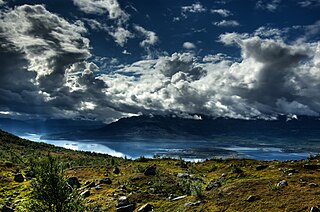
Norrbotten County is the northernmost county or län of Sweden. It borders Västerbotten County to the southwest, the Gulf of Bothnia to the southeast. It also borders the counties of Nordland and Troms in Norway to the northwest, and Lapland Province in Finland to the northeast.

Ångermanland (help·info) is a historical province (landskap) in the northern part of Sweden. It is bordered by Swedish Lapland, Västerbotten, the Gulf of Bothnia, Medelpad and Jämtland. Prince Nicolas of Sweden is Duke of Ångermanland.
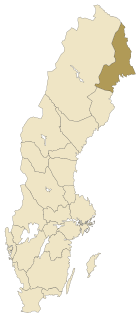
Norrbotten, known in English as North Bothnia, is a Swedish province (landskap) in northernmost Sweden. It borders south to Västerbotten, west to Swedish Lapland, and east to Finland.

Delaware Colony in the North American Middle Colonies consisted of land on the west bank of the Delaware River Bay. In the early 17th century the area was inhabited by Lenape and possibly the Assateague tribes of Native Americans. The first European settlers were the Swedes and the Dutch, but the land fell under English control in 1664. William Penn was given the deed to what was then called "the Lower Counties on the Delaware" by the Duke of York, in a deed separate from that which he held for the larger Province of Pennsylvania. Delaware was then governed as part of Pennsylvania from 1682 until 1701, when the Lower Counties petitioned for and were granted an independent colonial legislature, though the two colonies shared the same governor until 1776, when Delaware's assembly voted to break all ties with both Great Britain and Pennsylvania.

Karelia, the land of the Karelian people, is an area in Northern Europe of historical significance for Finland, Russia, and Sweden. It is currently divided among the northwestern Russian Federation and Finland.

The Torne, also known as the Tornio, is a river in northern Sweden and Finland. For approximately half of its length it defines the border between these two countries. It rises at Lake Torne near the border with Norway and flows generally southeast for a distance of 522 kilometres (324 mi) into the Gulf of Bothnia. It is the largest river in Norrbotten both by length and by watershed area.
The Treaties of Stockholm are two treaties signed in 1719 and 1720 that ended the war between Sweden and an alliance of Hanover and Prussia.

The Dal River is a river in central Sweden that flows from the north of Dalarna and runs into the sea in northern Uppland; it is commonly considered to be the southern border of Norrland, however only the last part correlates with Limes Norrlandicus. The northern part is split into two rivers: Österdalälven and Västerdalälven. The two connect in Djurås. It is over 520 kilometres (320 mi) long — the second longest river in Sweden, and has a hydropower potential of 1420 megawatts, of which 2/3 is utilized. The largest power plant is located at the Trängslet Dam. Dalälven has been significant historically as a raft transport route. Nedre Dalälven River Landscape, Sweden, covers 308,000 hectares (1,190 sq mi) with a mixture of wetlands, rivers, lakes, flood plains and productive forests. It includes Lake Hovran and Färnebofjärden Bay Ramsar site.
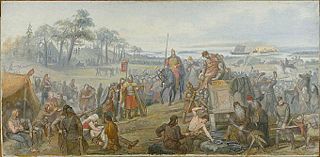
Fyrisvellir, Fyris Wolds or Fyrisvallarna was the marshy plain (vellir) south of Gamla Uppsala where travellers had to leave the ships on the river Fyris (Fyrisån) and walk to the Temple at Uppsala and the hall of the Swedish king.
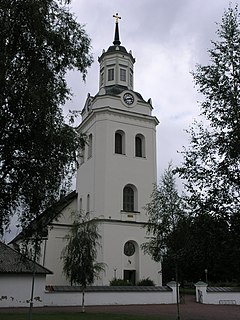
Orsa is a locality and the seat of Orsa Municipality, Dalarna County, Sweden, with 5,308 inhabitants (2010). It is located in the northern part of lake Siljan, about 15 kilometres north of the town Mora. Inlandsbanan and European route E45 run through the town and the railroad Bollnäs-Orsa connects.
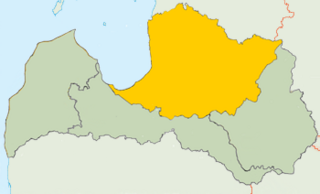
Vidzeme is one of the historical and cultural regions of Latvia. Literally meaning "the Middle Land", it is situated in north-central Latvia north of the Daugava River. Sometimes in German, it is also known as Livland, the German form from Latin Livonia, though it comprises only a small part of Medieval Livonia and about half of Swedish Livonia.

The Treaty of Stettin of 4 May 1653 settled a dispute between Brandenburg and Sweden, who both claimed succession in the Duchy of Pomerania after the extinction of the local House of Pomerania during the Thirty Years' War. Brandenburg's claims were based on the Treaty of Grimnitz (1529), while Sweden's claims were based on the Treaty of Stettin (1630). The parties had agreed on a partition of the Swedish-held duchy in the Peace of Westphalia (1648), and with the Treaty of Stettin determined the actual border between the partitions. Western Pomerania became Swedish Pomerania, Farther Pomerania became Brandenburgian Pomerania.

Rostojávri (Northern Sami), Råstojaure (Swedish), or Store Rostavatn (Norwegian) is a lake on the border between Norway and Sweden. The Norwegian side of the lake is located in Målselv Municipality in Troms county and the Swedish side of the lake is located in Kiruna Municipality in Norrbotten County. The Norwegian part of the lake lies inside Øvre Dividal National Park. The lake lies at an elevation of 680 metres (2,230 ft) and covers a total area of 34.24 square kilometres (13.22 sq mi); with 3.67 square kilometres (1.42 sq mi) located in Norway and the remaining 30.57 square kilometres (11.80 sq mi) are located in Sweden.

Öre River is a river in Sweden.

Tverrvatnet or Tvervatnet [tvær'vatne] is a lake in the municipality of Rana in Nordland county, Norway. The European route E12 highway passes along the northern and eastern shores of the lake between the town of Mo i Rana and the border with Sweden. Tverrvatnet gets its name from the fact that it is located "across", in a north-south direction, while most lakes in Rana are located in an east-west direction.

The VegaExpedition of 1878–1880, named after the SS Vega and under the leadership of Adolf Erik Nordenskiöld, was the first Arctic expedition to navigate through the Northeast Passage, the sea route between Europe and Asia through the Arctic Ocean, and the first voyage to circumnavigate Eurasia. Initially a troubled enterprise, the successful expedition is considered to be among the highest achievements in the history of Swedish science.
Konstvägen sju älvar is a tourist and sculpture route in Västerbotten in North Sweden that travels 350 kilometers in from the coast.



















